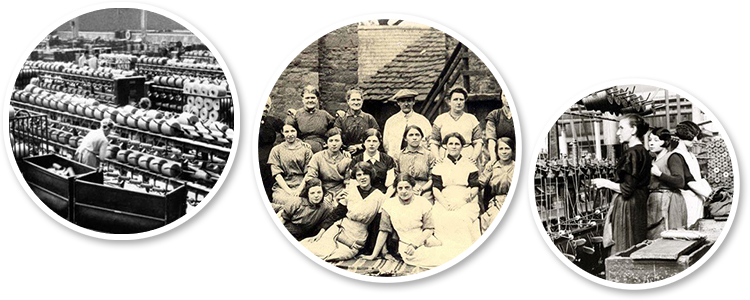Weaving was big business in Dundee as far back as the 16th century. After the Union with England in 1707 ended military hostilities, Dundee recovered from the devastation of the Siege of Dundee by General Monck in 1651 and established itself as an industrial and trading centre.
The whaling industry which left such a huge impact in Dundee began in 1753 and ignited a parallel ship building industry. In 1820 when the first delivery of jute arrived in the city, Dundee’s industries were well placed to capitalise on this new industry. The historical weaving industry, the ship building industry built the big, fast ships to bring the jute back from India and the whaling industry provided the whale oil needed for softening the jute fibres. Today it is easy to forget just how much of life in Dundee revolved around jute. We were the jute capital of the world often referred to as ‘juteopolis’, processing over 1 million bales of jute by 1900. The population of Dundee more than tripled in 60 years from 1841 to 1901 and was in fact higher than today. Over 50,000 of Dundee’s inhabitants were working in over 100 jute mills, with more working in mills for linen.
This booming business in Victorian made many rich jute barons as they were known. But these were the few profiteers of the industry, and the conditions were dire for the vast majority of workers. As many as three-quarters of the workers were women and children, who could be employed for cheaper rates than men. The wages were low, and the risks were high. Health and safety was not what it is today, and injuries, accidents and occupational hazards were commonplace. It’s difficult to imagine the working conditions, dust would be everywhere getting in the eyes, noses and mouth. Constant noise from the machines was deafening, and in fact many workers went deaf after spending too much time inside the mill. The machinery also produced lots of heat, grease and oil fumes which led to a condition which was known as ‘Mill fever’. Bronchitis and other breathing problems were also common.
Ever present in the mills was the risk of accident and injury, and the local newspapers have many accounts. Verdant works website notes an accident in Verdant Works Mill on 26th March 1852: ‘On Tuesday afternoon a girl employed in Verdant Mill got entangled about a carding machine and sustained such injuries before she could be released as to occasion instantaneous death’.
Some years previous, in 1839, Sir David Barry submitted the findings of his investigations into the conditions of the Dundee mills to Parliament. Included in this report were lists of workers who had been in accidents at work, or whom were suffering physically.
10-year old boys, Robert Malcolm and Hugh Cook were reported as missing one arm, as well as 11-year old Jane Lappen – most likely a direct result of life in the mills. Many more children and adults were reported as having missing limbs or horrific disfigurements, having fallen foul of the fast-moving machinery. Many more were reported to be partially amputated somewhere their body, more often than not the foot, arm or hand. Joan and Thomas Murtree, 16 and 15 respectively, both showed differing syptoms; the latter more serious than the former, causing Sir David Barry to write “likely to die”.
A tragic accident reported in 1853 reads:
‘Accidental Death: We regret to record the death of James Clark, a worker at Verdant Mill, which took place on Wednesday evening in consequence of an accident which happened to him while attending his employment on the previous day. It appears he was caught by a belt of the machinery which carried him rapidly to the roof of the building where he was three times revolved round one of the shafts before he could be extricated. He was conveyed to the Infirmary as soon as possible, but the poor fellow was so much bruised that death was the result’.
As well as the terrible conditions in the mills, the huge increase in population from 1840 to more than triple within 60 years was not met by an increase in house building. Overcrowding became a huge problem with entire families living in a single room. These conditions remained with 70% of people living in just one or two rooms in 1911. Certain areas such as Blackness and Lochee were especially overcrowded due to the common practice of people living close to their workplaces. When you’re working 12 hours a day slaving away in a mill, the last thing you want to do is live a long walk away.
Overcrowding inevitably led to poor sanitary conditions. Diseases including cholera, typhus and smallpox thrived in the city, and together with accidents and other infections and fevers contributed to Dundee having one of the highest death rates in Scotland, and the highest infant mortality rate.
The whole city suffered poor health, which showed when 50% of the men who volunteered at the local army recruiting office in 1911 were rejected as unfit for service because of their health.
Wages in Dundee were one of the lowest in Scotland during this time, whereas the cost of living was the highest. Low wages meant little money for food, medicine or other items necessary for a good quality of life.
Work in the mills of 19th century Dundee offered little except the promise of more bleakness.
Images courtesy of Local Photos (Dundee)
– DD Tours operates walking tours in Dundee city, covering dark local history such as wars, battles, murders, diseases, riots, disasters and executions. Walk with us for an unforgettable storytelling experience.
OR
